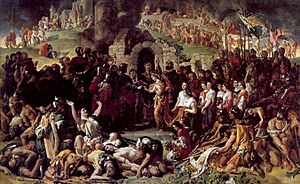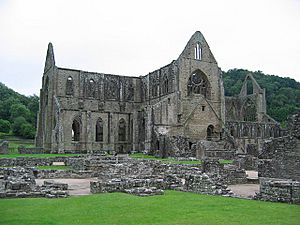Isabel de Clare, 4th Countess of Pembroke facts for kids
Quick facts for kids
Isabel de Clare
|
|
|---|---|
| suo jure Countess of Pembroke and Striguil | |
| Born | c. 1172 Leinster |
| Died | 11 March 1220 Chepstow, Wales |
| Noble family | De Clare |
| Spouse(s) | |
| Issue |
|
| Father | Richard de Clare, 2nd Earl of Pembroke |
| Mother | Aoife of Leinster |
Isabel de Clare (born around 1172 – died 11 March 1220) was a very important and wealthy noblewoman. She was known as the 4th Countess of Pembroke and Striguil in her own right. This means she inherited these titles and lands herself, not through her husband.
Isabel came from a powerful Anglo-Norman and Irish family. Her parents were Aoife Macmurrough and Richard de Clare. She married William Marshal, 1st Earl of Pembroke, who was considered one of the greatest knights of his time. He served three kings of England as the Marshal of England, a very important job. Their marriage was arranged by King Richard I.
Contents
Isabel's Family and Inheritance

Isabel was one of two known children of Earl Richard "Strongbow". Her brother, Gilbert, was born in 1173 but sadly died young, sometime after 1185. When Gilbert passed away, Isabel became the only heir to her parents' huge estates. These lands were in England, Wales, and Ireland.
Isabel's mother, Aoife, was the daughter of Diarmait Mac Murchada, who was once the King of Leinster in Ireland. Her parents, Strongbow and Aoife, married in August 1170. This happened right after Strongbow's forces captured the city of Waterford.
Isabel's grandfather was Gilbert de Clare, 1st Earl of Pembroke. Her father, Richard Strongbow, had lost the Pembrokeshire estate early on. However, he still used the title "Earl of Striguil," which was linked to his lands in Wales. The title of Earl of Pembroke was not forgotten. In 1199, it was given to Isabel's husband, William Marshal. This was because Isabel had a strong family claim to it. Before 1199, William Marshal always called her "Countess Isabel."
People described Isabel as "the good, the fair, the wise, the courteous lady of high degree." It is said that she could speak French, Irish, and Latin. After her brother Gilbert died, Isabel became one of the wealthiest heiresses in the kingdom. Besides her titles, she owned a lot of land in Wales and Ireland. She also had a claim to many castles around Milford Haven, including Pembroke Castle.
Because she was so wealthy and important, King Henry II became her guardian. He made sure her inheritance was protected. In 1189, the King placed her in the care of Ranulf de Glanville, who was a chief justice in England.
Marriage to William Marshal

In August 1189, the new King Richard I arranged Isabel's marriage. She was to marry William Marshal, who was known as the greatest knight and soldier in the country. King Henry II had promised Marshal that he would marry Isabel. King Richard, Henry's son, kept that promise.
At the time of her wedding, Isabel was living in the Tower of London. She was under the protection of the Justiciar of England, Ranulf de Glanville. The wedding was a grand event in London. After the ceremony, they spent their honeymoon in Stoke d'Abernon in Surrey.
Marrying Isabel made William Marshal one of the richest men in the kingdom. He went from being a military captain to a powerful lord. He served four kings as the Lord Marshal of England: Henry II, Richard I, John, and Henry III. Although William Marshal did not become Earl of Pembroke until 1199, he gained control of Isabel's vast lands. These included Leinster in Ireland and the lordships of Chepstow and Usk in Wales.
William and Isabel did not travel to Ireland until 1200, after taking control of Pembroke. Isabel sometimes ruled Leinster in her husband's absence. She may have governed there until 1203. She is also known for helping to establish the town of New Ross in Ireland. In 1207-1208, Isabel again ruled Leinster. Even though she was pregnant, she successfully led a campaign against rebellious barons in the province.
Their marriage was a happy one, even though there was a big age difference between them. William Marshal and Isabel had ten children together: five sons and five daughters.
Isabel's Later Life and Children
Isabel lived for only ten months after William Marshal died. However, this was a very busy time for her. She took full control of her inheritance. She quickly wrote to important officials asking for her lands to be given to her. By June 1219, she was officially given control of her lands in England and Ireland. She also gained the lordship of Striguil.
In July, she traveled to France. There, she successfully negotiated with King Philip Augustus to keep her family's lands in Normandy. She also started talks for her eldest son to marry his cousin. This caused some worry in the English court, and King Henry III even offered his own sister as a bride for Isabel's son. Isabel and her son managed their large estates well.
In February 1220, Isabel became very ill at Chepstow. She died on 11 March 1220. She was buried in the family abbey of Tintern Abbey, next to her mother Aoife.
Isabel's Children
Isabel and William Marshal had many children who became important figures:
- William Marshal, 2nd Earl of Pembroke (1190–1231): He became the Chief Justice of Ireland. He married twice.
- Richard Marshal, 3rd Earl of Pembroke (1191–1234): He died without children.
- Maud Marshal (1192–1248): She married three times and had many children. Five of King Henry VIII's wives were her descendants!
- Gilbert Marshal, 4th Earl of Pembroke (1194–1241): He married twice. He had one daughter before he became an earl.
- Walter Marshal, 5th Earl of Pembroke (1196–1245): He married, but had no children.
- Anselm Marshal, 6th Earl of Pembroke (1198–1245): He married, but had no children.
- Isabel Marshal (1200–1240): She married twice and had children from both marriages. King Robert I of Scotland and several of King Henry VIII's wives were her descendants.
- Sibyl Marshal (1201–before 1238): She married and had children. Queen consort Catherine Parr was a descendant.
- Joan Marshall (1202–1234): She married and had children. Queen consorts Jane Seymour and Catherine Parr were descendants.
- Eva Marshal (1203–1246): She married and had children. Queen consorts Anne Boleyn, Jane Seymour, Catherine Howard, and Catherine Parr were her descendants.
Isabel's Legacy
A special monument was found in St. Mary's Church, New Ross, Ireland. It has an inscription that might say "Isabel of Leinster" and a picture thought to be her. However, later research showed that her real burial place was at Tintern Abbey.
Some historians have suggested that Isabel might have encouraged the writing of The Song of Dermot and the Earl. This old poem tells the story of her father and grandfather. However, the poem does not mention Isabel or her husband. It was probably written before Isabel and William Marshal took full control of their lands in Ireland.
It is interesting that Isabel's five sons all died without having any children, except for Gilbert, who had one daughter before he inherited the earldom. Because of this, the Marshal family line ended. The title of Marshal later went to Hugh de Bigod, who was married to Isabel's eldest daughter, Maud. The title of Earl of Pembroke eventually went to William de Valence, 1st Earl of Pembroke, who married Joan de Munchensi, a granddaughter of Isabel.
Isabel and William Marshal's children and grandchildren married into many noble families across Europe. Their descendants include many kings and queens. This includes all the monarchs of Scotland since Robert I and all the monarchs of England and the United Kingdom since Henry IV. Also, Katherine of Aragon and all of King Henry VIII's English wives were descendants of Isabel de Clare.
| Peerage of England | ||
|---|---|---|
| Preceded by Gilbert de Clare, 3rd Earl of Pembroke |
Countess of Pembroke 1185–1220 |
Succeeded by William Marshal, 2nd Earl of Pembroke |

